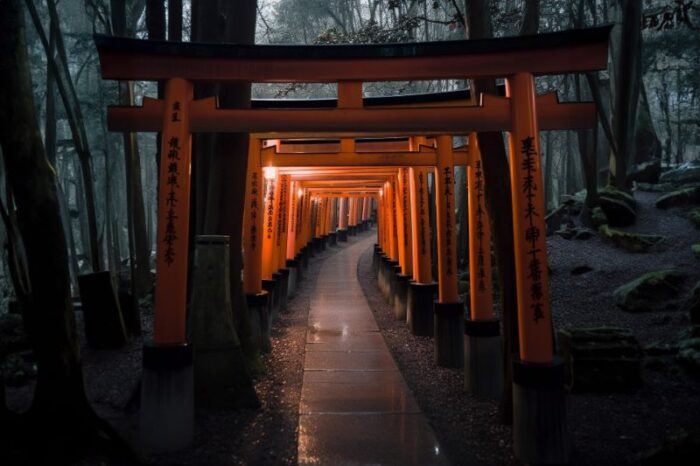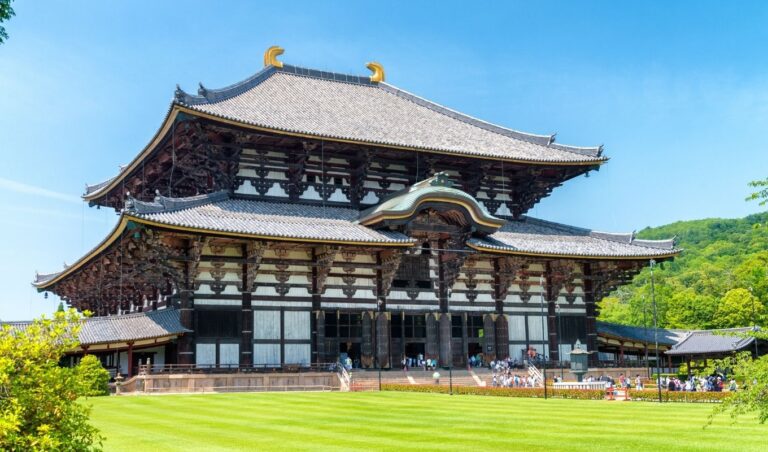Hatsumode, a cherished Japanese tradition, holds historical significance and is steeped in traditional rituals. Let’s take a look at the preparation and planning involved in this sacred practice, as well as popular Hatsumode locations.

Customary offerings play a vital role in this annual event, but modern interpretations have added a contemporary twist. Join us on a journey to uncover the essence of Hatsumode and discover how this ancient ritual continues to thrive in today’s fast-paced world.
Key Takeaways
- Hatsumode is a traditional Japanese New Year’s custom that dates back to the Heian period.
- It is a way to start the new year with auspicious blessings and is a social event that brings communities together.
- The rituals of Hatsumode involve offering prayers, making wishes, and receiving omamori from the shrine.
- Hatsumode has evolved with the times, with virtual experiences and social media integration becoming popular.
Historical Significance

Hatsumode is a traditional Japanese New Year’s custom where people visit Shinto shrines or Buddhist temples to pray for good fortune and a prosperous year ahead.
This practice dates back to ancient times and is deeply rooted in Japanese culture. It is believed that hatsumode started during the Heian period (794-1185) when people would gather at shrines to offer prayers and seek blessings for the coming year.
Today, hatsumode continues to be a cherished tradition, symbolizing a fresh start and the opportunity to leave behind the past year’s troubles. It holds a special place in the hearts of the Japanese people, reminding them of their cultural heritage and the importance of seeking spiritual guidance.
Traditional Rituals

The significance of Hatsumode, the first shrine visit of the year in Japan, is deeply rooted in Japanese culture and traditions. This annual ritual is believed to bring blessings and good fortune for the coming year.
During Hatsumode, people offer prayers, make wishes, and receive omamori, protective amulets, from the shrine.
Understanding the significance and rituals of Hatsumode provides insight into the spiritual practices and beliefs of the Japanese people.
Significance of Hatsumode

Visiting a shrine during hatsumode is a way for individuals to start the new year with auspicious blessings. It is a deeply rooted tradition in Japan, where people gather at shrines to pray for good fortune, health, and happiness in the coming year.
Hatsumode is not just a religious practice, but also a social event that brings communities together. The atmosphere at shrines during this time is vibrant and festive, with food stalls, traditional performances, and bustling crowds.
People write their wishes on small wooden plaques called ema, which are then hung at the shrine, symbolizing their hopes and dreams for the year ahead. It is a time of reflection, renewal, and setting intentions for the future.
Hatsumode allows individuals to connect with their spirituality and embrace the possibilities that the new year brings.
Ritual Practices Explained
During this ritual, it’s customary to cleanse your hands and mouth before entering the shrine. This cleansing process is known as ‘misogi’ and is an important part of the hatsumode experience in Japan.
The idea behind this practice is to purify oneself both physically and spiritually before approaching the sacred space. It involves using a ladle to pour water over your hands and then rinsing your mouth. This act of purification is believed to remove impurities and negative energy, allowing for a fresh start in the new year.
It’s a powerful and symbolic gesture that signifies the desire for renewal and spiritual growth. By participating in this ritual, individuals can feel a sense of liberation and freedom, ready to embark on a new chapter of their lives.
Preparation and Planning
Before going to the shrine for hatsumode, it’s important to make a list of all the necessary preparations. Planning ahead ensures a smooth and enjoyable experience.
First, one must decide on the date and time of the visit. It’s best to avoid the busiest days to avoid the crowds.
Next, it’s crucial to dress appropriately for the occasion. Many people choose to wear traditional clothing such as kimono or yukata. Don’t forget to bring a small purse or wallet for offering money and a small towel for cleansing.
It’s also customary to bring a small notebook or ema board to write wishes or prayers.
Lastly, it’s important to mentally prepare oneself for the spiritual experience and embrace the freedom to express gratitude and hopes for the coming year.
Popular Hatsumode Locations

To make the most of your experience, consider exploring popular locations for hatsumode in Japan.
Hatsumode, the first shrine visit of the New Year, is an important tradition in Japanese culture. It is a time for reflection, gratitude, and setting intentions for the year ahead.
While there are countless shrines across Japan where you can participate in hatsumode, some locations stand out for their historical significance and vibrant atmosphere.
One such location is Meiji Shrine in Tokyo, nestled in a serene forest, where you can experience a sense of tranquility amidst the bustling city.

Another popular choice is Fushimi Inari Taisha in Kyoto, famous for its thousands of vermilion torii gates that create a breathtaking path for visitors to follow.

Wherever you choose to go, these popular hatsumode locations offer a unique and memorable way to start the year with a sense of freedom and possibility.
Customary Offerings
When participating in traditional Japanese customs such as hatsumode, there are customary offerings that play an important role.
One such offering is traditional food, which is often presented as a gesture of gratitude and respect to the deities.
Symbolic monetary donations are also commonly made, symbolizing prosperity and good fortune for the upcoming year.
Plus, ritualistic prayer items, such as incense and prayer beads, are used during the prayer rituals to create a sacred and spiritual atmosphere.
These offerings and rituals help to create a meaningful and personal connection with the spiritual world during the hatsumode experience.
Traditional Food Offerings
You can participate in hatsumode by making traditional food offerings at the shrine. It is a customary practice in Japan to bring food as an offering to the deities during the New Year’s visit to the shrine.
Traditional food offerings vary depending on the region, but some common ones include mochi, rice cakes, and fruits. Mochi, made from pounded rice, is often shaped into round balls or squares and is considered a symbol of good luck and prosperity. Rice cakes, on the other hand, symbolize the hope for a bountiful harvest in the coming year. Fruits represent the abundance and sweetness of life.
Symbolic Monetary Donations
If you want to make a symbolic monetary donation at the shrine, consider offering a small amount of money in a special envelope called ‘osaisen.’ This traditional practice allows visitors to show their respect and support for the shrine’s upkeep and activities.
The osaisen envelopes are usually available near the shrine entrance or at designated donation boxes. You can write your name or a wish on the envelope before placing it in the donation box.
The amount of money you choose to offer is up to you, but it is customary to give a modest amount, such as 500 yen or 1000 yen. The osaisen envelopes are often beautifully designed and can serve as a meaningful souvenir of your visit.
Ritualistic Prayer Items
To fully participate in the ritualistic prayer at the shrine, bring along specific items like omamori, a small amulet, or ema, a wooden plaque, to write your wishes on and hang them up. These items play an essential role in the hatsumode experience, allowing visitors to connect with the spiritual and cultural traditions of Japan.
Omamori, meaning ‘protection,’ are believed to bring good luck and ward off evil. Carrying one can bring a sense of comfort and security.
Ema, on the other hand, serve as a way to communicate wishes and desires to the deities. By writing your wishes on the wooden plaque and hanging it up, you are symbolically offering your prayers.
These items not only enhance the spiritual connection but also create a personal and meaningful experience for those participating in hatsumode.
Modern Interpretations
Take a moment to explore modern interpretations of hatsumode during your visit to Japan. Hatsumode, the traditional New Year’s visit to shrines and temples, has evolved over the years to reflect the changing times. While the core essence of the ritual remains intact, there are now alternative ways to participate in hatsumode that cater to those seeking more freedom and personalization.
In recent years, some people have chosen to have a ‘virtual’ hatsumode experience by using technology to visit shrines and temples online. This allows individuals who may not be able to physically attend the ceremonies to still partake in the spiritual aspect of hatsumode.
Another modern interpretation of hatsumode is the integration of social media. Many shrines and temples now have their own official accounts where they share updates, photos, and even livestream the New Year’s ceremonies. This allows people to connect with the spiritual community and share their own hatsumode experiences with a wider audience.
Whether you choose to participate in hatsumode traditionally or explore these modern interpretations, the essence of the ritual remains the same – to start the New Year with gratitude, reflection, and a sense of renewal.
Frequently Asked Questions
How Long Has Hatsumode Been Celebrated in Japan?
Hatsumode, a traditional Japanese New Year’s custom, has been celebrated for centuries. It involves visiting a Shinto shrine or Buddhist temple to pray for good fortune and make wishes for the upcoming year.
Are There Any Specific Prayers or Rituals Performed During Hatsumode?
During Hatsumode, people in Japan perform specific prayers and rituals to bring good luck and blessings for the new year. These rituals vary, but commonly include making offerings, ringing bells, and drawing omikuji fortunes.
What Are Some Common Traditions or Customs Associated With Hatsumode?
Some common traditions or customs associated with Hatsumode include visiting a shrine or temple, making offerings, praying for good fortune and health, buying lucky charms, and participating in various ceremonies and rituals.
How Do People Usually Prepare for Hatsumode?
People usually prepare for Hatsumode by cleaning their homes, buying new clothes, and making resolutions for the upcoming year. It’s a time for reflection and renewal, where people strive to start the year on a positive note.
Are There Any Specific Locations in Japan That Are Particularly Popular for Hatsumode Celebrations?
There are certain locations in Japan that attract a lot of attention during hatsumode celebrations. These places are known for their beautiful shrines or temples and are popular among people looking for a spiritual start to the new year.
The Sum Up
To sum it up, hatsumode is a time-honored tradition in Japan that holds great historical significance. It is a chance for individuals to start the new year on a positive note and seek blessings for the year ahead.
The preparation and planning involved in this ritual are crucial, as they ensure a meaningful experience. Popular locations for hatsumode include shrines and temples across the country. Offering customary items like coins and prayers is a customary practice that adds depth to the experience.
Today, hatsumode continues to evolve, allowing individuals to find their own modern interpretations of this cherished tradition. So why not join in and embrace the spirit of hatsumode for a fresh start in the new year?




